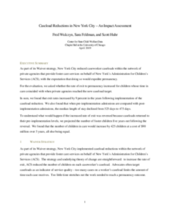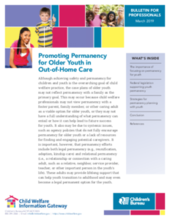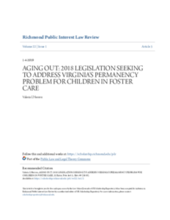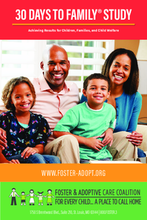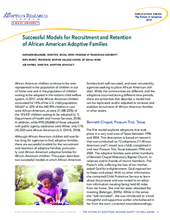Displaying 61 - 70 of 232
For this evaluation, the authors asked whether the rate of exit to permanency increased for children whose time in foster care in New York City coincided with when private foster care agencies reached the new reduced caseload target.
This bulletin provides information for child welfare professionals about the importance of permanency for youth and strategies for achieving it. Permanency efforts for youth should include both legal permanency (e.g., reunification, adoption, kinship care) and relational permanency (i.e., a relationship or connection with a caring adult, such as a relative, neighbor, service provider, teacher, or other important person in the youth's life). These adults may provide lifelong support that can help youth transition to adulthood and may even become a legal permanent option for the youth.
This study utilized administrative data that reviewed child welfare cases in a Midwestern state in the U.S. to examine interactions between teamwork and parent engagement associated with the permanency of children in out-of-home care.
This study examined the predictive power of the Strength and Difficulties Questionnaire (SDQ) for predicting foster placement breakdown.
To inform decisions about permanent care arrangements, the authors of this study used Swedish national population registers to create a sibling population consisting of 194 children born 1973–1982 who had been in out-of-home care (OHC) at least 5 years before adolescence but were never adopted (50% boys) and their 177 maternal birth siblings who also had been in OHC at least 5 years before their teens but were adopted before adolescence (52.5% boys).
This article by staff attorney for family law and child welfare at the Virginia Poverty Law Center's Center for Family Advocacy, Valerie L’Herrou, outlines and analyses several new bills introduced by the Virginia General Assembly in 2018 and their impacts on young people aging out of the foster care system and family reintegration.
When children are adopted from the care system staying in touch with members of their birth families must be considered.This research paper draws on the English experience.
This brief from the Foster & Adoptive Care Coalition in the United States provides an overview of the 30 Days to Family® program in the U.S. state of Missouri, an intense, short-term intervention developed by the Foster & Adoptive Care Coalition to: 1) increase the number of children placed with relatives/kin at the time they enter the foster care system; and 2) ensure natural and community supports are in place to promote stability for the child.
This paper describes two successful models in which African American families both self-recruited, and were recruited by agencies seeking to place African American children.
This article describes some of the research outcomes and the ongoing work of the research collaboration between University College Cork (UCC) and Tusla – Child and Family Agency which sought to make a contribution to fostering stability through applying the approach of traumainformed care.

